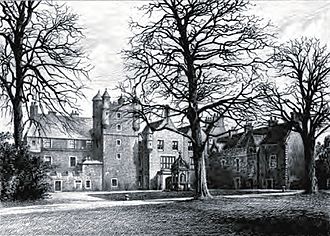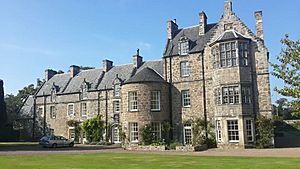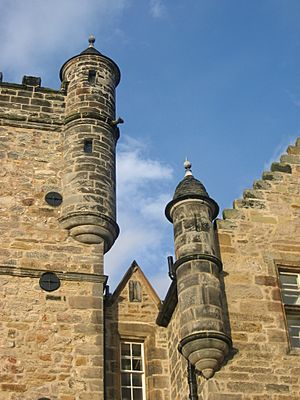Pinkie House facts for kids
Quick facts for kids Pinkie House |
|
|---|---|

Historical drawing of Pinkie House c. 1882
|
|
| General information | |
| Type | Historic house |
| Town or city | Musselburgh |
| Country | Scotland |
| Coordinates | 55°56′33″N 3°02′38″W / 55.94262°N 3.043934°W |
| Opened | 16th century |
| Renovated | Early 17th century |
| Owner | Loretto School |
| Technical details | |
| Floor count | 3 |
Pinkie House is a very old and important building in Musselburgh, East Lothian, Scotland. It was built around a three-storey tower house in the 16th century. The house was made much bigger in the early 1600s and has been changed many times since then.
You can find Pinkie House east of Musselburgh town centre, on the south side of the High Street. Today, it is part of Loretto School, which is a private boarding school. Pinkie House is also close to where the famous Battle of Pinkie Cleugh took place in 1547.
Contents
What's in a Name? The Story of "Pinkie"
The name "Pinkie" has been around for a long time, first written down in the 12th century as Pontekyn. Some people think it comes from old Welsh words. Pant means "valley" and cyn means "wedge." This might describe how the house sits at the end of the Esk valley.
However, a more likely idea is that "Pinkie" comes from a mix of French and Scots words. "Pont Ekin" could mean "bridge over the River Esk." This makes sense because the house is near the river.
A Look Back: The History of Pinkie House
Pinkie House used to be the country home for the Abbots of Dunfermline. The original tower house was built in the 1500s. It stands on the very spot where the Battle of Pinkie happened.
From Monks to Earls: A New Owner
After the Scottish Reformation in 1597, the house went to Alexander Seton. He was a very important person, serving as the main advisor (called a chancellor) to King James VI. In 1605, King James made him the Earl of Dunfermline.
Young Prince Charles, who later became King Charles I, lived here as a boy. This was after his father, King James, moved to London in 1603. Prince Charles even slept in a room still known as "The King's Room."
Seton's Grand Additions
In 1607, Seton married his third wife, Margaret Hay. From 1613, he started making Pinkie House much larger. He added a long wing to the south side and decorated the inside beautifully.
There's a Latin message on the house that tells us about Seton's work. It says he "planted, raised and decorated a country house" and "brought together everything that might afford decent pleasures of heart and mind."
The Long Gallery inside Pinkie House is famous for its special pictures and sayings. When the writer Ben Jonson visited in 1619, he even asked about these unique decorations. Seton also made changes to his other castle, Fyvie Castle, before he passed away in 1622.
New Owners and More Changes
In 1694, the property was passed to the Hay family. The Marquess of Tweeddale added a new door to the east side of the house.
In 1745, after winning the Battle of Prestonpans, Charles Edward Stuart, also known as "Bonnie Prince Charlie," stayed at Pinkie House. He also used the building as a hospital for his soldiers.
In 1778, the Hays sold the house to Sir Archibald Hope, 9th Baronet. He made more changes and added a stable building in 1800. More updates and changes were done in 1825 by the architect William Burn.
Pinkie House Today: Loretto School
In 1951, Loretto School bought Pinkie House. The school made more changes in the 1970s, adding two new buildings in the grounds. A new section was built on the north side. The south wing is now the headmaster's house.
The rest of Pinkie House is used for many things by the school. It includes a boarding house for older boys. Students at Loretto School also take their exams in the beautiful painted gallery.
Exploring Pinkie House: What It Looks Like
Pinkie House was first built as an L-plan tower house. This means it looked like the letter 'L' from above. Over the years, many parts were added in the 17th, 18th, and 19th centuries.
The oldest part is a five-storey tower. Seton added small turrets (called bartizans) and a special wall with gaps (a crenellated parapet) to the top. This tower was connected to a strong, three-storey main building with a sloped roof. Seton also changed this part, adding square turrets.
Inside the oldest part, there's a basement with a curved ceiling. A wide spiral staircase (called a turnpike stair) leads up to the second floor. The inside of the house has been updated over time.
Seton's Grand Gallery and Art
Seton's biggest addition was the long, three-storey south wing. On its top floor is the amazing 96-foot-long Painted Gallery. The person who built this part might have been William Wallace, a famous mason.
On the south side of the house, there's a bay window. This type of window was new to Scotland in the early 1600s. The east side of the house has seven tall chimneys. The long gallery has a beautiful wooden ceiling with paintings inspired by classical art. Many other rooms have plaster ceilings from the 17th century. A smaller painted ceiling was moved in 1951 to the Huntly House museum in Edinburgh. Later inside designs were done by William Burn.
Above one of the doors, a Latin message says that "Alexander Seton built this house not to the measure of his desire, but of his fortunes and estate." This means he built it as grand as he could afford.
Gardens and Features
To the east of the house, there is a walled garden. It has a shelter, a doocot (a pigeon house), and a sundial. In the corner of the 'L' shape of the house, to the west, there is a beautiful Renaissance fountain or well. This highly decorated structure was built around 1610.
Gallery










